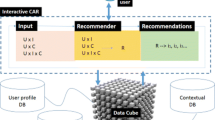Abstract
A personalized service in the ubiquitous environment is to provide services or items, which reflect personal tastes, attitudes, and contexts. It is impossible to reflect the context information generated in u-healthcare environments due to the existing recommendation system performing the recommendation using the information directly input by users and application usage record only. This study develops a context-aware model using the context information provided by the context information model. The study applies it to the extraction of the missing value in a collaborative filtering process. The context-aware model reflects the information that selects items by users according to the appropriate context using the C-HMM and provides it to users. The solution of the missing value in the preference significantly affects the recommendation accuracy in a preference based item supply method. Thus, this study developed a new collaborative filtering for ubiquitous environments by reflecting the missing preference value and reflecting it to the collaborative filtering using the context-aware model. Also, the validity of this method will be evaluated by applying it to menu services in u-healthcare services.









Similar content being viewed by others
References
Balabanovic M, Shoham Y (1997) Fab: content-based, collaborative recommendation. Communication of the Association of Computing Machinery 40(3):66–72
Breese JS, Kadie C (1998) Empirical analysis of predictive algorithms for collaborative filtering. Proceedings of the 14th Conference on Uncertainty in Artificial Intelligence, Madison, WI, pp. 43–52
Brown PJ, Bovey JD, Chen X (1997) Context-aware application: From the laboratory to the marketplace. IEEE Personal Communication, pp. 58–64
Burchfield TR, Venkatesan S (2007) Accelerometer-based human abnormal movement detection in wireless sensor networks. In the 1st ACM SIGMOBILE international workshop on Systems and networking support for healthcare and assisted living environments San Juan, Puerto Rico
Gong L (2001) A software architecture for open service gateways. IEEE Internet Computing 5(1):64–70
Good N, Schafer JB, Konstan JA, Borchers A, Sarwar B, Herlocker J, Riedl J (1999) Combining collaborative filtering with personal agents for better recommendations. Proceedings of the National Conference on Artificial Intelligence, pp. 439–446
Jang S, Woo W (2003) ubi-UCAM: A unified context-aware application model. Context03, pp. 178–189
Jeong K, Won J, Bae C (2008) User activity recognition and logging in distributed Intelligent Gadgets. In IEEE International Conferenceon Multi sensor Fusion and Integration for Intelligent Systems
Jung KY, Lee JH (2004) User preference mining through hybrid collaborative filtering and content-based filtering in recommendation system. IEICE Transaction on Information and Systems E87-D(12):2781–2790
Jung KY, Choi JH, Rim KW, Lee JH (2003) Development of design recommender system using collaborative filtering. LNCS 2911, Proceedings of the 6th International Conference of Asian Digital Libraries (ICADL'03), pp. 100–110
McDonald DW, Mark SA (2000) Expertise recommender: a Flexible recommendation system and architecture. Proceedings of the ACM Conference on Computer Supported Cooperative Work, pp. 231–240
New Life Hypertension & Diabetes Clinic, http://www.goliving.co.kr
Rabiner LR (1989) A tutorial on hidden Markov models and selected application in speech recognition. In Proc IEEE 77(2):257–286
Ravi N, Dandekar N, Mysore P, Littman ML (2005) Activity recognition from accelerometer data. In American Association for Artificial Intelligence, pp. 11541–1546
Ungar LH, Foster DP (1998) Clustering methods for collaborative filtering. Proceedings of the Workshop on Recommendation Systems, pp. 114-129
Welltizen, http://neps.welltizen.com
Wojek C, Nickel K, Stiefelhagen R (2006) Activity recognition and room-level tracking in an office environment. in IEEE International Conference on Multisensor Fusion and Integration for Intelligent Systems Heidelberg, Germany
Acknowledgment
This research was supported by Basic Science Research Program through the National Research Foundation of Korea funded by the Ministry of Education, Science and Technology. (No. 2011-0008934).
Author information
Authors and Affiliations
Corresponding author
Additional information
This paper is significantly revised from an earlier version presented at the International Conference on Information Science and Applications 2011.
Rights and permissions
About this article
Cite this article
Kim, J., Lee, D. & Chung, KY. Item recommendation based on context-aware model for personalized u-healthcare service. Multimed Tools Appl 71, 855–872 (2014). https://doi.org/10.1007/s11042-011-0920-0
Published:
Issue Date:
DOI: https://doi.org/10.1007/s11042-011-0920-0




